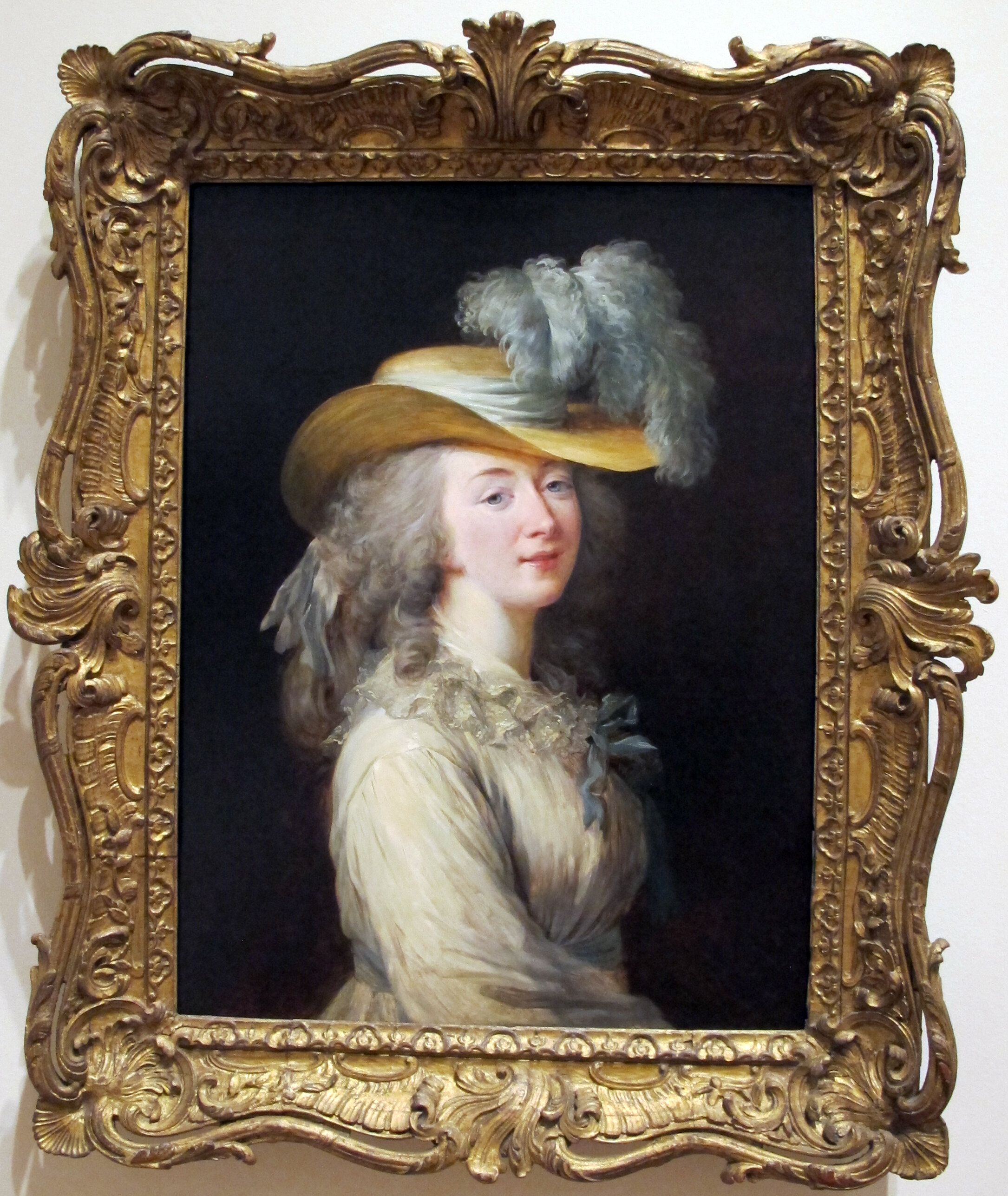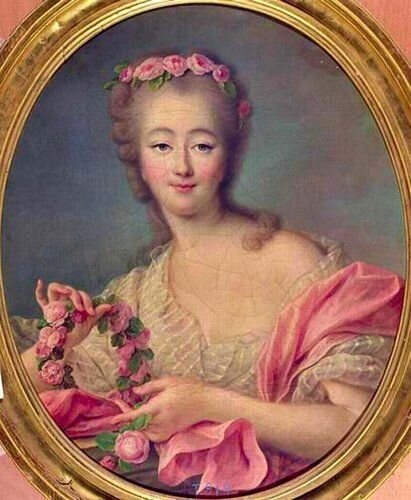The list of mistresses of the kings of France is long. For Louis XV, sandwiched between two of the most famous kings might be best known for his many lovers than for the man himself.
After Madame de Pompadour who we have also talked about, Madame du Barry definitely left her mark on Versailles and a very young Marie Antoinette. Jeanne Bécu was born on August 19, 1743 in Vaucouleurs in the north east of France. Her mother Anne Bécu who was known for her beauty and her father was unknown. It is thought that her father could be a Franciscan monk, Jean-Jacques Baptiste de Vaubernier. Anne had worked as a seamstress at the local convent and could be where the scandalous act occurred.
Anne Bécu married in 1749, Jeanne was just six years old and would be sent to the convent in the Latin Quarter. She would stay for six years until she escaped at the age of 15 and wandered the streets selling tiny trinkets out of a box on the streets of Paris.
Finding a job as an apprentice to a hairdresser, Lametz who she also was in a relationship with until she obtained all of his money and moved on. Later working in a perfume shop and as an assistant to a hatmaker, picking up one odd job after another until one day she met a man at a Paris casino.
Jean-Baptiste du Barry owned a casino and also a brothel. He was instantly struck by her beauty and knew he must have her. The two became an item but he also convinced her to work as a prostitute and courtesan for him. She was instantly popular with the elite and men at court. Frequent trips to Versailles to see the Minister of Foreign Affairs, Duc de Choiseul who was a very loyal customer. In 1768, while leaving Versailles she was spotted by Louis XV who was still mourning the death of Madame de Pompadour, but the beautiful young lady intrigued him.
Louis XV asked his valet Dominique Guillaume Lebel to find out who she was and to invite her back to court. One visit to his bedroom and she became a fixture in the court of Versailles. However, a woman of the night without a title didn’t fit in well. Everyone at court talked about the “harlot” that crossed the sacred entrance to his bedroom.
When you are king this is always an easy fix. On September 1, 1768 married the brother of her “pimp” Guillaume du Barry at the Eglise Saint Laurent in Paris. The man that performed the ceremony, Jean-Jacques Baptiste de Vaubernier, her possible father. Fake papers were created with a new noble lineage, but the people at court were not fooled. Following the ceremony Guillaume was quickly sent away from Paris.
The new Madame du Barry still had to be presented at court to make it official. Cardinal Richelieu who had also been a former lover asked Madame de Béarn to take the role as her sponsor and in return he would eliminate her husband’s debt to the king. She didn’t like the idea and when the big day came she faked a sprained ankle. It couldn’t be put off anymore, the king wanted du Barry and on April 22, 1769 dressed in a beautiful white dress with silver thread and gems she was officially a member of court.
However, this didn’t erase the past and everyone knew where she came from. Without a friend at court, Louis XV would bribe the ladies to be friends with her. On May 15. 1770, a young Austrian princess arrived at the Chateau de la Muette. It was the moment Marie Antoinette was going to meet her new family and the day before her wedding to Louis XVI. At a lavish dinner, for what was to be just family Madame du Barry took her seat next to the king. The Comtesse de Noailles filled Marie Antoinette in on the story of du Barry and left a fast first impression on her.
For almost two years Marie Antoinette refused to speak to her. Madame du Barry thought she should be the top woman at court but with the arrival of the future queen she was quickly knocked down a few notches. Things became so bad that the Ambassador of Austria, the Queen of Austria and Louis XV had to step in. Marie was told that if she didn’t talk to her it could ruin their entire alliance and she could be sent back.
On January 1, 1772, Marie walked up to du Barry, and said “There are many people at Versailles today” it was the only words she would ever speak to her but solidified the entire union.
Louis XV was thirty-three years older than his mistress and was in very ill health. Contracting small pox he laid on his death bed with his daughters and du Barry by his side. When he was told he only had days to live he sent du Barry away so he could take his confession and try to redeem himself in the eyes of the church in his last moments. On May 10, 1774 Louis XV would take his last breath and the reign of Madame du Barry came to an end.
Louis XVI and Marie Antoinette would exile her from court and wasn’t allowed to come within ten miles of Versailles which included her Chateau in Louveciennes. She returned to her former profession, this time with a little more selection. One man after another wanted to marry her but she had no interest.
As the Revolution began to gain speed in France she tried to stay quiet to protect herself. She thought as the former head mistress she would be saved. A long time servant that had been with her since her days at court, Zamour had become involved with the Jacobins and fighting with the Revolutionist. When she confronted him about it she told him to quit the Jacobins or be fired.
Zamour returned to Paris and told his friends all about the life of Madame du Barry and that she was trying to find anyone who could help her escape France. Before she could leave she was arrested and taken to the Revolutionary Tribunal in 1793 and accused of treason, that came with a sentence of death.
For months she was held at the Saint Pélagie prison before she was taken to the anti-chamber of death, the Conciergerie, just like Marie Antoinette. Du Barry thought she could talk her way out of it by offering to tell them all of the hiding places for her large wealth of jewels.
On December 7, 1793 she was sentenced to death. When it was announced she screamed and fainted. She was told to write down the places they could find her jewels and for three hours she thought she was in the clear. It was a rather naive move. As soon as her list was complete the executioner arrived, cut her hair and placed her on the cart that would take her through the streets of Paris to the guillotine.
In the dark of night in the early hours of December 8, 1793 she moved to her death. The enter way she was screaming and crying forcing the executioner to try to end her life as fast as possible. Pleading and screaming until the second the blade dropped she tried to make a deal to save her life. After her body was tossed into a grave at the Madeleine cemetery, the same one Marie Antoinette had arrived just a few months before
Madame du Barry was a big supporter of the arts and was instrumental in bringing the Neo-Classical design to Versailles as well as the artist Elisabeth Vigee Le Brun.




